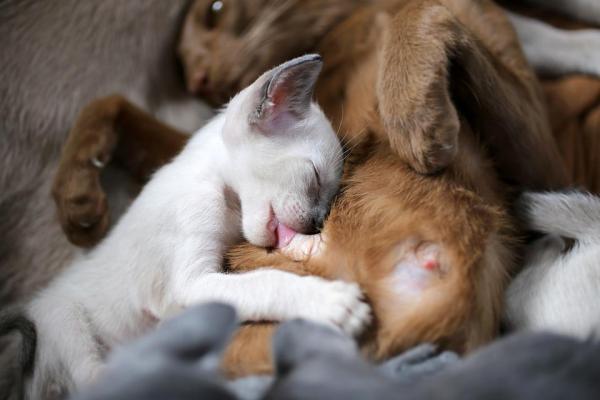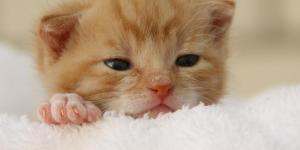Weaning Kittens - Kitten Feeding Guide



See files for Cats
In the first stage of life, newborn kittens don't need anything more than their mother's milk to develop. They don't yet have the skills or physical capability to feed for themselves. This stage does not last forever and eventually they will need to gain independence and eat solid food. It is a process known as weaning and it coincides with vital development of the kitten. At AnimalWised we bring you everything you need to know about weaning kittens with our kitten feeding guide. The main distinction we need to make when weaning kittens is between those fed by their mother and those which are bottle fed. We show you how nature takes care of their feeding or how you might need to do it yourself.
What do newborn kittens eat?
Before we explain more about the weaning process of kittens, we should provide some background information on their dietary requirements. These aspects of feeding not only help them grow physically, but their interaction with mother and siblings is important for their general well-being.
When they first enter the world, a kitten is very vulnerable. Not only are they physically weak, but their immune system is not yet developed. This means an infection is difficult to fight, so nutrition is vital in keeping them safe from harm. This is why the first milk produced by the mother is a nutrient rich form of milk known as colostrum. It contains a much higher level of necessary protein than regular milk, as well as providing antibodies to fight any infection.
Kittens are surrounded by an amniotic sac which the mother will bite open. They will then cut the umbilical cord and begin to lick the kitten to stimulate breathing and remove secretions. Almost immediately after they are born the kitten will be directed toward the nipple by their mother. The kitten's instinct will make them suckle and the mother will lactate immediately.
Breast milk will be the kitten's exclusive diet for the first few weeks of life. This milk completely covers their nutrition and helps to meet their basic needs in terms of physical and psychological development. Additionally, mother and offspring communicate during feeding which helps to begin their basic social skills. The kittens will purr as a sign of well-being. This way the mother knows their kittens are being cared for satisfactorily. The kittens will instinctively massage their mother's breasts to stimulate milk production when they want to feed.
Kittens are born with both their eyes and ears closed and will spend the majority of their day sleeping. At around 8 days of life their eyes will begin to open. Approximately one week later at about 15 days of life, they will take their first steps. At around 3 weeks, they will slowly start eating solid food and reduce their milk consumption. This is the weaning process whereby reliance on milk is gradually replaced by eating solid food.

When to wean kittens?
As we state above, the mother cat will start weaning the cat at around 3 weeks of age. Even with new mothers, cats will know how to care for their young through instinct. Not all newborn kittens are lucky enough to have a mother. Whether the mother has died or they have been separated for whatever reason, they will need a surrogate. While it is not ideal, we can take over the kitten's care if necessary.
Another reason a mother might not be able to feed their kitten is due to disease. Breast milk not only passes on nutrients and antibodies. If the mother cat is infected with a virus, there is bacteria around the breast or if there is a genetic predisposition to certain conditions, then breastfeeding is not recommended. They should be removed from the queen (mother) and bottle fed[1].
The kitten will need milk almost immediately after they are born. If we don't have the mother's colostrum, they will need to be bottle fed. In this case, we need to purchase an artificial alternative. You can buy these online, although you will likely need to get it from a local pet store if you are in an emergency situation. These products vary in quality. Choose one which is certified by your national governing body, e.g. by the USDA in the United States.
Colostrum contains immunoglobulins which is absorbed by the intestine. However, this absorption stops after about 24 hours after birth[2]. From this time onward, the mother will start producing the regular mother's milk. If bottle feeding, you will have to switch to kitten milk formula which can be purchased from most pet stores.
Weaning kittens on to solid food is not an exact science. There will be cats which show interest in food a little later and others which are more precocious. Above all, we need to bear in mind it is a gradual process. Breast milk will also be part of the kitten's diet for up to 6 to 8 weeks of life. The kitten may still want to suckle at their mother, but she will reject them if they do.
How to wean kittens
Now we know the timeline for weaning kittens, we should explain more about how it is done. There are different types of food we can use, but we need to ensure it is specially formulated for kittens. We can choose to prepare homemade food, but this can be tricky as we need to ensure they have the right nutrients.
If we opt for dry food, we should know the kitten's teeth will have trouble breaking it down. What we can do is add a little warm water to make it softer and more palatable. If we choose wet food, we should be able to give it to them as it comes. You should mince it a little with a fork just in case. Some people think it is OK to feed cats leftover human food. This is not the case when weaning kittens. If we make homemade food, we need to check with the veterinarian to confirm the right nutrition. Cats are obligate carnivores and need animal protein to survive. Commercial kitten feed is also supplemented with necessary nutrients such as taurine.
After the initial three weeks of drinking their mother's milk exclusively, we need to offer them the solid food. Use a plate with low edges to facilitate access. We offer the food 2 to 3 times per day. The kittens should try to eat a little food and then return to their mother for suckling. If the kittens have no mother and are being bottle fed, we should offer them the plate of food before offering the bottle. Afterwards, they can drink as much milk as they need.
Little by little, we should notice them eating more solid food and drinking less milk. We should, therefore, adapt the quantities of each accordingly. It is also vital we offer plenty of water as they move on to solid food. Drinking milk only will provide sufficient hydration, but solid food only will not.
The weaning process for kittens should never finished before 6 to 8 weeks. If they are weaned too early they will not be able to ingested enough food properly and will miss out on necessary nutrition from the milk. There are also psychological consequences for when they become an older cat. They should not be separated from their mother and siblings too early. If the kittens are not orphaned, then the mother will naturally know when to stop breastfeeding them. If we are unsure about anything during the weaning process, do not hesitate to speak to your veterinarian for advice.

When should cats be separated from their mother?
Newborn kittens should remain with their mother wherever possible. If they are orphaned or have to be removed for health reasons, then it poses a significant risk to their health. This is why weaning a bottle fed kitten can be a delicate process. You need to be vigilant and observe for any signs or symptoms of health issues.
Kittens removed from their mother before a minimum of 8 weeks of life (ideally 12 or more) can suffer behavioral problems later in life. The biggest affect is their lack of socialization, i.e. their ability to interact with other cats, other animals and humans. If we look after an orphaned kitten, we need to be very careful with socialization. Give them the right level of interaction, but don't overstimulate them. We also need to wait until they are vaccinated and dewormed before introducing them to other cats or animals. This is because they are so vulnerable to disease.
Playing with the kittens is also important. It helps them to develop their bite inhibition, hone their hunting skills and become the best cat they can be. Read our article on caring for kittens if you want to know what other considerations you will need to make.

If you want to read similar articles to Weaning Kittens - Kitten Feeding Guide, we recommend you visit our Lactation category.







